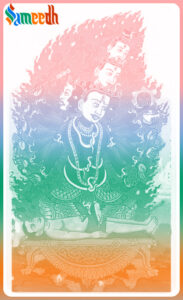In Hindu mythology and Tantric tradition, Kubjika is often regarded as both a form of the Goddess Devi and a consort or manifestation of Bhairav, a fierce aspect of Shiv. This duality reflects the interplay of feminine and masculine energies within the divine realm.

Goddess Kubjika, also known as Kubjika Mata, is a significant deity in the Tantric tradition of Hinduism, particularly within the Shakta and Kashmir Shaivism traditions. She is revered as a powerful and transformative goddess associated with both creative and destructive energies.
As a form of Devi, Kubjika embodies the feminine aspects of creation, nurturing, and transformation. She is worshipped as a compassionate mother goddess who guides her devotees towards spiritual realization and liberation. Devotees often seek her blessings for protection, prosperity, and inner strength.
At the same time, Kubjika is also associated with Bhairav, who represents the fierce and destructive aspect of Shiv. Bhairav is often depicted as a wrathful deity, wielding weapons and surrounded by flames, symbolizing his power to destroy ignorance and obstacles on the path to enlightenment.
The union of Kubjika and Bhairav symbolizes the union of Shakti (divine feminine energy) and Shiv (divine masculine energy) within the Tantric tradition. This union is seen as essential for achieving spiritual awakening and liberation.
Kubjika is often depicted as a fierce and dynamic goddess, typically portrayed with a hunched back, holding various weapons, and adorned with divine ornaments. Her iconography symbolizes her ability to overcome obstacles, destroy ignorance, and lead her devotees towards spiritual awakening.
In the worship of Kubjika, practitioners engage in various rituals, mantra recitations, and meditation practices aimed at invoking her presence and receiving her blessings. Devotees believe that by connecting with Kubjika’s divine energy, they can attain spiritual liberation and transformation.
Kubjika is also associated with the energy centers within the human body known as chakras, particularly the muladhara chakra located at the base of the spine. She is believed to reside within this chakra, representing the primal creative force and the potential for spiritual awakening.
In Tantric practices, devotees may worship Kubjika and Bhairav together, recognizing their complementary roles in the journey towards transcendence. Through rituals, mantra recitations, and meditation, practitioners seek to awaken the divine energies represented by Kubjika and Bhairav within themselves, leading to spiritual transformation and realization.
The worship of Goddess Kubjika has been influential in shaping Tantric practices, emphasizing the integration of spiritual and worldly aspects of life. Through devotion to Kubjika, practitioners seek to transcend limitations and realize their true divine nature.